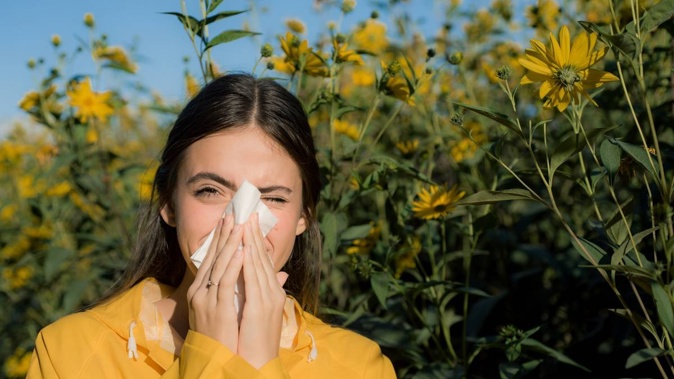
Hay fever sufferers are having a particularly bad summer this year as the strongest El Nino season in 80 years drives high levels of pollen into the air.
The warm, windy weather has stirred up so much yellow pollen that Auckland Council has reportedly fielded complaints from residents who thought yellow paint was being dumped in waterways.
New Zealanders with hay fever expressed their pain on social media, saying they were effectively under house arrest or using multiple toilet rolls a day to blow their noses.
“This year is so bad. I’m struggling,” said one person on Facebook. “Hay fever is ruining my life,” said another.
The condition is caused by fine pollen particles released by trees, plants and grasses over spring and early summer, leading to watery eyes, runny noses and relentless bouts of sneezing. It can also be triggered by dust mites and animal hair.
Pollen levels are not regularly measured in New Zealand. But researchers are this year carrying out what is believed to be the first pollen test in 35 years.
The researchers from Auckland and Victoria universities have mounted a device on the top of the Auckland War Memorial Museum which captures pollen grains. It is specially designed to inhale air in a similar way to a person’s breathing.
Daily samples are taken and researchers count the number of pollen seeds captured in the spaceship-like device. More than 30 pollen grains per cubic metre of air is considered “high”, which can trigger severe hay fever.
/cloudfront-ap-southeast-2.images.arcpublishing.com/nzme/H2NWS7KUHNC6PAFQFUKIQNMRXY.jpg) A team of scientists have set up a pollen trap atop Auckland War Memorial Museum to analyse fine particles flowing through our air. Pictured from left are University of Auckland researchers Dr Stuti Misra, Dr Amy Chan and Natasha Ngadi. Photo / University of Auckland
A team of scientists have set up a pollen trap atop Auckland War Memorial Museum to analyse fine particles flowing through our air. Pictured from left are University of Auckland researchers Dr Stuti Misra, Dr Amy Chan and Natasha Ngadi. Photo / University of Auckland
Professor Rewi Newnham, from Victoria University, said early results showed that the “high” threshold has been exceeded in Auckland on seven days since July. That is a 75 per cent increase compared to the last time pollen was measured in this way 35 years ago.
“The only point of comparison we’ve got is the same site in the late 1980s,” Newnham said. “But on the basis of our early data, it does appear to be worse in Auckland than the summer of 1988-89 for grass pollen and therefore for people with hay fever.”
University of Auckland researchers are also measuring any impact on 300 patients with asthma to record any correlations between the pollen levels and their condition.
Newnham said pollen levels were strongly dependent on seasonal weather and long-term climate change and longer-term data was needed to have confidence about whether levels were increasing each year.
Asthma and Respiratory Foundation CEO Leticia Harding said the high rates of pollen were likely to be driven by the El Nino climate pattern.
“That means warmer, strong winds that pick up a lot of pollen and circulate it. That’s why people are feeling it a bit more this year.”
Harding said one of the telltale signs of high pollen levels were the yellow particles which collected on car windscreens and in gutters.
“We’ve had people even ring councils to say it looks like someone’s dumped paint in the waterways. But actually it’s yellow pollen that’s on the water.”
Harding said people who had both asthma and hay fever could struggle badly in high pollen seasons.
/cloudfront-ap-southeast-2.images.arcpublishing.com/nzme/POFQX3SC7FHNFDJ4C2MA4LHUHI.png) Asthma and Respiratory Foundation chief executive Letitia Harding said El Nino's warm, strong winds is driving high levels of pollen.
Asthma and Respiratory Foundation chief executive Letitia Harding said El Nino's warm, strong winds is driving high levels of pollen.
In previous El Nino summers, there was an association between thunderstorms and asthma attacks. In 2017, 14 people were hospitalised in the Waikato region after suffering attacks following a storm.
“Basically, it’s thought in a thunderstorm, large numbers of pollen are lifted up high in these warm, windy updrafts that El Nino is creating and then they’re ruptured into fragments and dispersed really widely at ground level,” Harding said.
“And of course that gets deep into the lungs and can be a trigger for asthmatics. So that is something to be conscious of.”
The foundation encouraged patients to do an “asthma warrant of fitness” before the holiday period: seeing their GP or pharmacist to make sure prescriptions and inhalers were up to date.
Forecasters say this summer’s El Nino could be the strongest New Zealand has experienced in 80 years.
National Institute of Water and Atmospheric Research (Niwa) said people in the north and east of the North and South islands, where conditions were particularly warm during spring, could be exposed to more pollen than usual.
Isaac Davison is an Auckland-based reporter who covers health issues. He joined the Herald in 2008 and has previously covered the environment, politics, and social issues.
Take your Radio, Podcasts and Music with you









